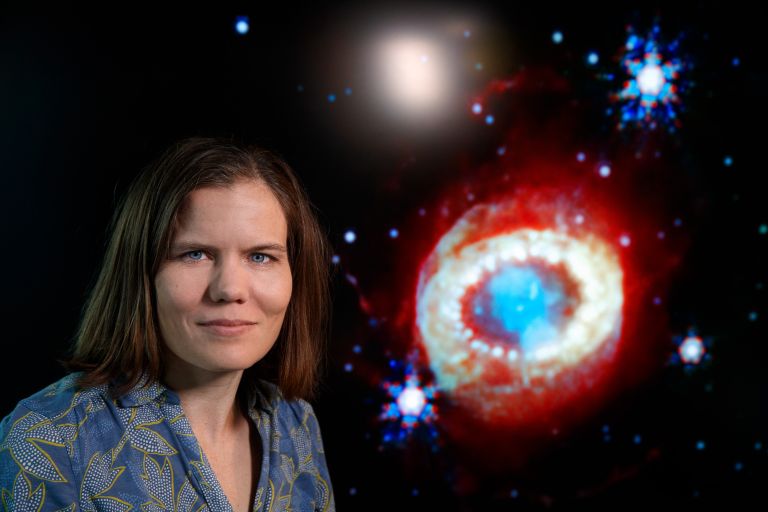
Josefin Larsson
Professor of Astrophysics
Wallenberg Scholar
Institution:
KTH Royal Institute of Technology
Research field:
Supernovae, jets, and compact objects


Wallenberg Scholar
Institution:
KTH Royal Institute of Technology
Research field:
Supernovae, jets, and compact objects
A massive star ends its life in a violent explosion, a supernova. Enormous amounts of energy are released in just a few seconds, and the supernova can briefly shine a hundred billion times brighter than our sun.
But supernovae are more than mere beautiful astronomical phenomena; they are also the starting point for vital processes.
“At the beginning of the universe, only hydrogen and helium were formed. Most heavier elements are created inside stars and in supernova explosions and are dispersed into the universe with them,” says Larsson, who is a professor of astrophysics at KTH Royal Institute of Technology.
During the explosion, the outer parts of the star are ejected into space, where they become building blocks for new stars and planets. Shock waves from the explosion can also trigger star formation in surrounding gas clouds. The core of the star collapses into either a neutron star or a black hole, which may later on give rise to a wide range of astronomical phenomena.
Despite their importance, many aspects of supernovae remain shrouded in mystery. Larsson aims to change that.
One key question is how these explosions are triggered. To investigate this, Larsson has developed methods to create three-dimensional images of how the material ejected from the star, the so-called supernova remnant, spreads in space.
“The geometry of the ejected material reflects what happened at the moment of the explosion.” By analyzing it, we gain knowledge about the star before the supernova and the mechanisms behind the explosion,” she says.
Her research team is analyzing the light from the supernova remnant, broken down into different wavelengths – its spectrum. Each element creates unique patterns in the spectrum, known as “spectral lines,” which reveal the distribution of various elements in the remnant. Shifts in these spectral lines also indicate the direction in which the material is moving.
Larsson has made analyses of this kind for the supernova remnant SNR0540, which exploded 1,100 years ago. She has demonstrated that the material spread very asymmetrically in space and that the various elements have formed complex structures of rings and clumps.
The explosion and collapse occur within a second. The supernova and its remnant then evolve over hundreds of thousands of years.
She has also used observations from the James Webb Space Telescope to perform 3D analyses of the supernova remnant SN 1987A. It exploded in the same small neighboring galaxy as SNR0540, and the light from the explosion reached Earth in 1987. She plans to analyze more elements in greater detail and has also been granted time to aim the telescope at SNR0540.
“The James Webb Telescope is a fantastic tool for this. It will be interesting to see how many new things it will tell us about supernova remnants. I believe there will be many surprises.”
A compact object forms at the center of a supernova: a neutron star or a black hole. Larsson is studying these phenomena to understand how their properties relate to the characteristics of the star and the nature of the explosion.
Her research partly builds on a breakthrough she was recently involved in, alongside researchers from Stockholm University and international colleagues. Using observations from the James Webb Telescope, they showed that the remnant of supernova 1987A is a neutron star – something long suspected but previously unconfirmed.
“It was great to finally see this signal! It also appeared in a way we hadn't quite expected; we saw lines from argon gas, which hadn't been included in theoretical calculations before.”
Larsson’s team has also developed a method to more accurately determine the properties of even more distant compact objects. This method estimates the object’s luminosity by analyzing how X-rays are absorbed by surrounding matter.
With new telescopes and instruments, astronomers can now observe phenomena previously beyond reach. But there is also great potential in observations collected from older telescopes, as Larsson explains:
“Researchers often have exclusive access to data for a year, after which everything is stored in open archives. When a telescope has been operational decades, there is an incredible amount of data we can review to see whether any interesting signals have been recorded.”
Her team is searching for X-ray flashes, which could be the very first signals from supernovae, as well as signs of compact objects in locations where a supernova has occurred.
Nowadays, astronomers discover new supernovae every day. However, this is not because they are common but because the universe is vast. In a galaxy like ours – the Milky Way – an average of just one supernova occurs per century. The last one happened in 1604, raising hopes of witnessing a new one soon.
“It’s about time.” It would be fantastic for the entire research field to study a nearby supernova with all the telescopes we now have at our disposal,” says Larsson.
Text Sara Nilsson
Translation Maxwell Arding
Photo Magnus Bergström
A star is a spherical celestial body of hot gas. At its core, the pressure and temperature are so great that atomic nuclei of lighter elements fuse to form heavier elements, a process called fusion. This process releases energy and creates an outward pressure that counteracts the inward pull of gravity.
When a massive star can no longer fuse lighter elements into heavier ones – when its fuel runs out – gravity becomes stronger than the outward pressure, and the star collapses under its own weight. The inner parts are compressed into a small but extremely dense object. At the same time, the outer layers fall inward and bounce back, triggering the explosion: the supernova. Stars can likely explode in different ways, and exactly how it happens remains unclear.